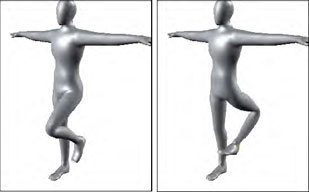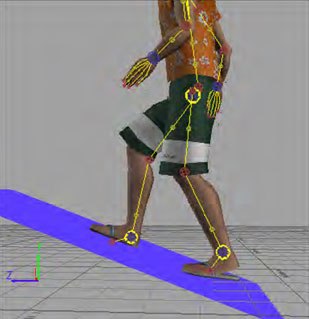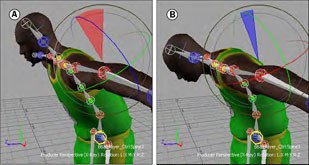Alain Bielik wraps himself around the CG creatures and other creepy vfx that inhabit Slither.

The continuing saga of consolidation amongst 3D software developers marches on, but apparently no news is good news. We all felt the earth shake recently when Autodesk purchased 3D rival software developer Alias. The gigantic headlines foretold confusion for animators and 3D artists all around. The strange thing is that now, months later, little news has followed. The release of Alias MotionBuilder 7.5 doesnt change anything regarding the future of either company. As curious as we all may be, the PR pros are doing an admirable job of keeping the focus on the products and not on the business machinations. Only time will tell what Autodesk has in store for the Alias product line. The good news, for now, is that there is a new version of MotionBuilder for us to play with.
MotionBuilder 7.5 is the latest upgrade to the popular character animation software. This review was conducted on a pre-release beta version; the final shipping version may contain slight variations. For folks unfamiliar with MotionBuilder, it is a character animation package offering many innovative, production oriented tools in addition to its ability to export in a multitude of formats. A full review of MotionBuilder can be found in this September 2005 VFXWorld article. This review will focus mostly on the new features and improvements found in the MotionBuilder 7.5 upgrade.
One of the best things about MotionBuilder is how well it integrates into pipelines. This is mostly due to its ability to import and export a wide variety of file formats. Version 7.5 ups the ante by introducing FBX Converter, a separate utility app. Just a few years ago, I recall spending thousands on a standalone piece of software to do nearly the same job, and, sadly, not much else. This feature alone may be worth the upgrade cost, depending on your studios reliance on the FBX format. The utility will convert 3DS, DXF, OBJ and Collada files to .FBX, and the same files from FBX. In addition to these conversions, the utility will also allow users to convert from one FBX format to another. This is useful for importing old files into newer software. The utility functions well, with the only obvious limitation being a lack of configurable options for converting Collada files; however, this may only be a limitation of the beta version used for this review.
Namespace, meanwhile, is a new feature that allows users to group objects simply by using a common naming convention. A namespace is really a hierarchy, with some helpful tools built in. As an example, imagine a building as a group of objects. Each object within the building would be named something like building:office or building:chair. Namespaces take over by renaming new objects in a scene to match the current naming convention and avoid objects with duplicate names. Adding an object named chair would be problematic, but the namespace accommodates the new chair by altering the name to building:office:chair. The end result of using namespaces properly is easy selection of categories or sub-categories of characters or objects within your MotionBuilder scene.
The bulk of the new features are related specifically to characters. Some are simple workflow enhancements, such as the ability to load multiple files at once and reset control rigs when opening files. Other enhancements are more substantial; for example, the inverted joints option, which allows users to reverse joints. This feature is important for animating birds as well as a wide variety of fantastic creatures that have freaky inverted joints. The new roll solver is off by default; the version 7.0 is on by default. Choosing the new 7.5 roll solver makes the local rotation of IK effectors of elbows and knees stay in synch with the local rotations of the first FK roll objects in the arms and legs. This makes it easier to correctly animate elbows and knees, avoiding odd limb twisting.

The heart of MotionBuilder is the control rig, so it is another obvious choice for improvement in any upgrade. Alias offers many improvements, including rotation enhancements, floor collisions and control rig customization. Additive rotation on a hierarchy is now possible by using local reference mode. Rotations are relative to the parent of any given object. This makes creating bends in long appendages, such as creature tails, easier and more fluid. Improvements to floor collisions are simple yet effective. Now, when a user characterizes a character, the floor collision node is created at an appropriate size relative to that character. This fixes a problem with characters that were created in Maya having overly large floor collisions nodes, also known as effectors.

The same relative scaling is now also true for control rig effectors. When attaching control rigs to characters MotionBuilder will now bring up a dialog box to warn/ask users if they want to keep any customizations they have done to the control rig or if they want to revert to the default control rig. Regardless of which choice the user makes, MotionBuilder will automatically disable any effectors that are not necessary for that particular character. An example of the usefulness of this feature is taking a control rig from a character with four fingers to a character with only two fingers. Once attached to the two-fingered character the control rig would have two fingers, on each hand, disabled. Like much of what has gone into this upgrade, this is another workflow speed improvement. Double solving is an improvement that falls outside the workflow speed realm and provides something unique, that could not be accomplished otherwise. Control rigs are great but can become useless when trying to create complex relationships between effectors. Having a hockey player character hold a stick with one hand doesnt present much of a problem, but if he winds up for a slap shot and grips the stick with two hands, problems may arise. Doubles solving takes away some of the difficulty by allowing one effector, a hand in this case, to drive another effector, the opposite hand. Double solving takes a bit longer but the results would take even longer to duplicate manually.

There are many animation improvements in this upgrade, including Bezier curve handling. The new Bezier-Clamp interpolation is now the default for Bezier curves. It assists animators by limiting the curves so they dont over or under target. Other new animation features are the ability to add a new keyframe without affecting the existing curve, duplicate keyframes by control dragging and the option to automatically convert a default Bezier curve to a user defined curve when a handle is dragged. Users may also now globally copy and paste translation and rotation keyframes between IK objects.
The interface has also been improved. Rotation snaps are now possible using presets defined in preferences or by using default values. Many shortcuts have been added, including selection, visibility and window switching. One of the less appealing additions, the new welcome page, falls under interface changes. It seems like Alias is going for a comic book style look here, but the execution is strictly amateur design. The content provided is solid, but the presentation is lacking. Users expect more polish from a mature piece of software. Hopefully the design is beta placeholder stuff and will be improved when the final product is released.

There are many minor changes in the upgrade too. A new look property has been added to allow users to show or hide all null objects within a scene. This null property is mostly of interest to Maya users as exports from Maya create visible nulls when imported into MotionBuilder. With this functionality the nulls can now be quickly and easily hidden. Undo and redo have been given some attention in this upgrade. Now, when an action cannot be undone, users will be given a dialog box warning and may choose to OK or cancel the action. This is useful but likely to become a mild annoyance once users are more familiar with the software. Handles now act more intelligently when keyframed. When a user sets an IK key, a keyframe will be applied to all the objects selected by the handle.
Autodesk has done well with this upgrade. They have honored the half version upgrade by fixing bugs, implementing workflow enhancements all while avoiding sweeping changes. MotionBuilder continues to fill a niche that no other software matches. It will be very interesting to see what they cook up for the next release, more than likely a beefy full version upgrade.
Autodesk MotionBuilder 7.5 is currently available to MotionBuilder Platinum Members only. The software is expected to become available to all users shortly. Pricing remains unchanged from version 7 at $4,195 and is available for both the Windows and Mac OS X platforms. Upgrade pricing was not available at the time this review was written. Check the Autodesk website for more information.
Fred Galpern is currently the art manager for Blue Fang Games, located just outside Boston. He is also a part-time Maya instructor at Northeastern University and a co-creator of the game development program at Bristol Community College. Since entering the digital art field more than ten years ago, Galpern has held management positions in several game and entertainment companies, including Hasbro and Looking Glass Studios. He began his art career in comic books and also has interactive, print and web graphic design experience.








